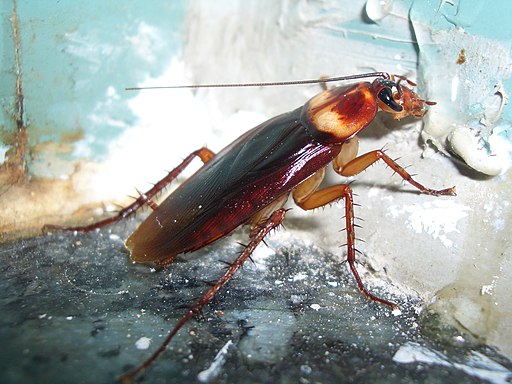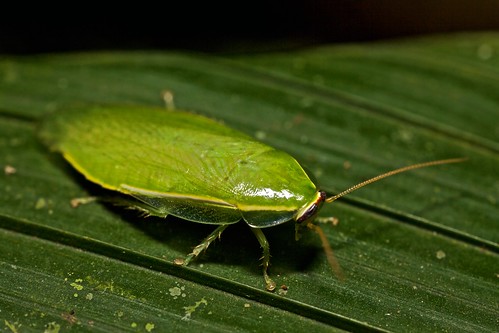Monday, January 3, 2011
What is a cockroach?
This is a cockroach, order Blattodea. Insects in the order Blattodea (or Blattaria if you're old-school - either way it's a roach) are characterized by long, slender cursorial (running) legs with which they achieve impressive speeds. The top of their first thoracic segment (aka the pronotum) extends up to cover their heads as a shield-shaped hat. Their mouths contain a pair of plain, sensible mandibles for chewing, their 30+ segmented antennae are thin and sensitive, ranging far ahead of their body to warn of impending danger as they run. In those cockroaches that have wings, the first pair is thickened, leathery (they're called tegmina), protecting the hind pair that is thin and membranous.
Many cockroaches are earth-toned: dull brown, tan, red, and black. A few, like the beautiful cuban cockroach (Panchlora nivea) pictured above, have striking coloration.
One thing a cockroach is not, however, is fancy. You will never find them trying to stand out with flashy patterns. They are meant to blend in with the background. Flat bodies, shielded heads, leathery forewings, the body of a cockroach is made for sneaking into small hiding places and for furtive avoidance of malicious predators. Their beauty is a functional one.
Labels:
antennae,
beauty,
blattaria,
cockroaches,
coloration,
form,
function,
insect legs
Sunday, January 2, 2011
Confessions of a Cockroach lover

MMMHHhh tasty water!
I have a confession to make. I am not afraid of cockroaches. I know, I should be. They carry diseases, they cause allergies, they're icky and run too fast. All of which, in any normal human being, should be cause for alarm.
But I just can't do it.
Why? Because they're just doing their jobs - fulfilling their cockroachy calling. Allow me to explain.
Living things are messy. It's true. We secrete and excrete and shed everywhere. When we eat, we always leave crumbs and sticky smears behind. Then we go and die and leave our messy bodies behind. Someone has to pick up the trash. A lot of times, that someone is an insect. Dung beetles specialize on picking up our crap. Ants will happily take our crumbs and lick up our sticky residues. Flies specialize on cleaning up our dead flesh after we've left this world. Cockroaches aren't really specialists. They are the garbage-men. You put it out, they pick it up.
We humans have taken messy up to a whole another level. We have made certain choices to live certain ways that create a lot of garbage. This garbage is typically a mixture of components, bits of organic matter hidden in pockets of inorganic containers and structures. The inorganic stuff is pretty useless to the rest of the living world (not entirely useless, but requiring a great deal of time and energy to return to a useful state) but the organic stuff someone can always use for food. But then who's going to go and extract it? What garbage-man would come into your house and take away all your crumbs from under the fridge? Lick our your yogurt containers, scarf up the stale cookies in your pantry, and clean the slime that clings to the inside of the drainplug in your tub? Cockroaches, that's who. They're the most effective garbage-men ever.
Their all-encompassing garbage-picking skills is what makes cockroaches susceptible to contamination by various nasty microbes. These valiant trash-men don't mind exploring your toilet brush and then your kitchen counters for delicious morsels. 'Clean dish' and 'dirty dish' is not a distinction that they know how to make. So the problem with cockroaches isn't so much the roaches themselves, but the microbes they accidentally pick up when they're on clean-up duty.
Funny thing about those microbes, though- they were already hanging around. In most cases, they were as close as your bathroom floor and your sink. The cockroaches just moved them around. Cross contamination: it's the worst kind of cooties.
So how do you keep the cockroach garbage-men on the curb? Keep your trash there too. Clean up after yourself, and the cockroaches won't have to come and do it for you.
Labels:
blattaria,
cockroaches,
disease,
entomophilia,
entomophobia,
garbage-men,
prejudice,
waste
Subscribe to:
Posts (Atom)
